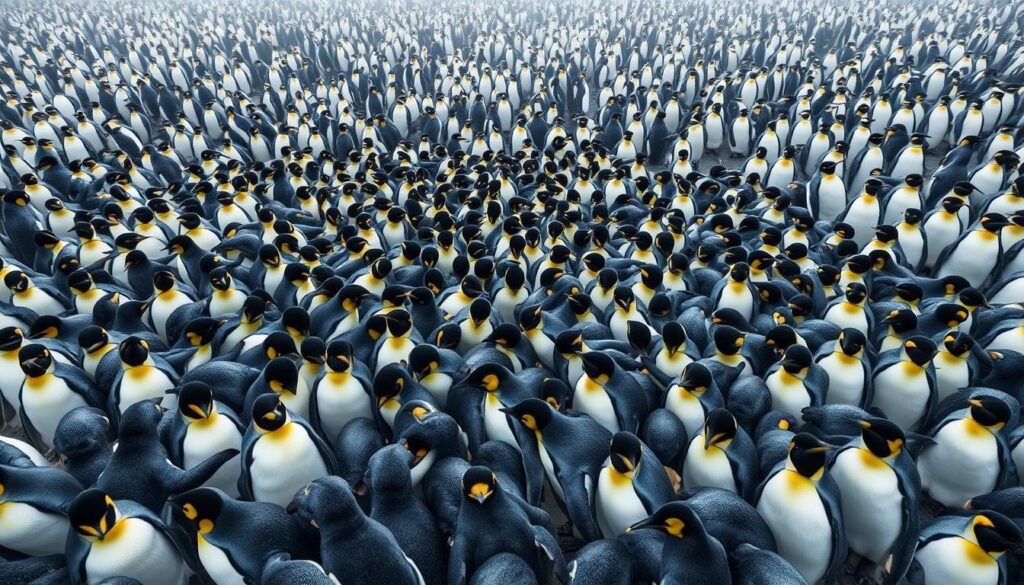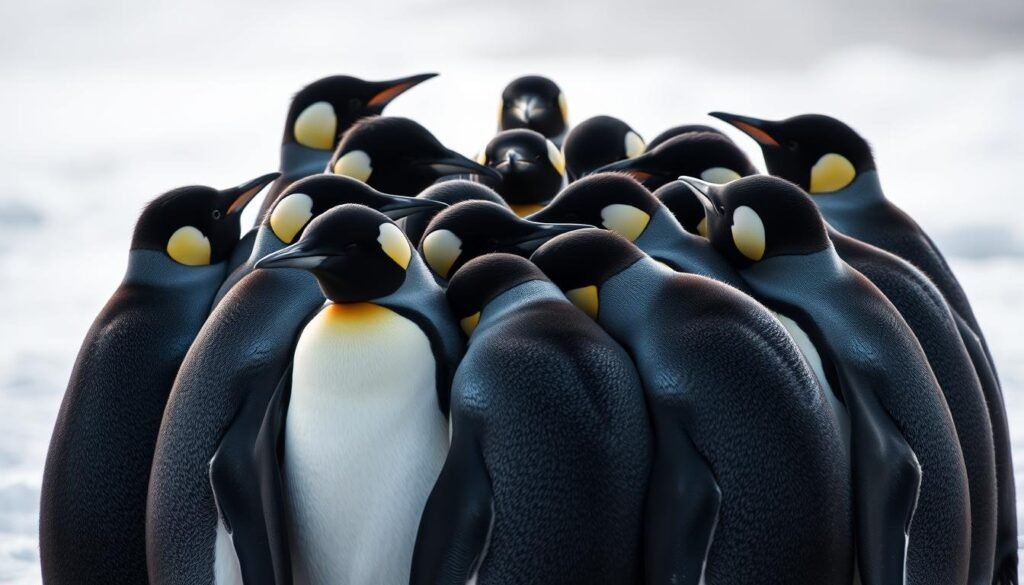Why Penguins Huddle in Cold Temperatures? Penguins live in some of the Earth’s coldest places. They are very social and have special ways to stay warm. One cool thing they do is huddle together in the cold.
This huddling helps them stay warm and safe from the cold. By studying penguin behavior, we learn about their social lives and how they handle the cold climate.
As we dive deeper, you’ll see how important huddling is for these amazing birds. [Why Penguins Huddle in Cold Temperatures?]
Contents
- 1 The Harsh Reality of Antarctic Living
- 2 Why Do Penguins Huddle Together in Cold Weather?
- 3 The Science Behind Penguin Huddles
- 4 Benefits Beyond Warmth: The Complete Huddling Advantage
- 5 Huddling Behaviors Across Different Penguin Species
- 6 The Complex Dynamics of Penguin Huddles
- 7 Human Research and Observations of Penguin Huddling
- 8 Conclusion: Why Penguins Huddle in Cold Temperatures?
- 9 FAQ
- 9.1 Why do penguins huddle together in cold temperatures?
- 9.2 How do penguins regulate their body temperature while huddling?
- 9.3 What are the benefits of huddling beyond just warmth?
- 9.4 Do different penguin species exhibit unique huddling behaviors?
- 9.5 How do penguin huddles maintain their structure and dynamics?
- 9.6 What research methods have scientists used to study penguin huddling behavior?
- 9.7 How does huddling help penguins during the breeding season?
- 9.8 What can we learn from penguins’ huddling behavior about adapting to extreme environments?
The Harsh Reality of Antarctic Living
Antarctica’s extreme environment pushes penguins to their limits, forcing them to adapt in remarkable ways. You are about to explore how these birds survive in one of the most inhospitable places on Earth.
The Antarctic landscape is characterized by extreme cold, with temperatures often dropping below -40°C in winter. Strong winds are another challenge, making the living conditions even more harsh. Penguins must withstand these conditions to survive.
To cope with these extreme conditions, penguins have developed unique penguin adaptations. Their feathers provide excellent insulation, trapping warm air next to their skin. Additionally, penguins have a layer of fat that helps to keep them warm in freezing temperatures.
The limited sunlight during the Antarctic winter is another challenge. Penguins have adapted to this by adjusting their breeding and feeding habits to the available light. Understanding these adaptations helps you appreciate the resilience of penguins in the face of harsh Antarctic living conditions.
Why Do Penguins Huddle Together in Cold Weather?
In Antarctica’s extreme cold, penguins huddle together for warmth. This is key to their survival. It helps them keep warm and shield themselves from harsh weather.
Penguins form huge groups, sometimes with thousands of birds. This way, they cut down on cold and wind exposure. It saves them energy. [Why Penguins Huddle in Cold Temperatures?]
Huddling does more than just keep them warm. It also strengthens their social bonds. This social behavior is vital for their health and survival.
| Benefits of Huddling | Description |
|---|---|
| Conserves Heat | Reduces heat loss by minimizing exposed surface area |
| Protects from Wind | Shields penguins from harsh Antarctic winds |
| Fosters Social Bonding | Encourages social interaction and community building |
Understanding huddling shows the complex social life of penguins. It highlights their adaptability and resilience in extreme conditions. [Why Penguins Huddle in Cold Temperatures?]
The Science Behind Penguin Huddles
Exploring penguin huddles reveals how they keep warm. They use a mix of physical and behavioral tricks. By huddling, they save energy that would be lost trying to stay warm alone.
Penguins keep their core warm through special body processes. But, their feet and flippers stay cold to help save energy. This helps them survive in very cold places.
Heat Transfer Efficiency
Huddling makes penguins more efficient at keeping warm. They pack close together, covering less skin from the cold. This shows how well their penguin physiology works in harsh weather.
The science of penguin huddles shows their amazing temperature regulation. By huddling, they lose less heat to the cold. This helps them survive in icy homes.
Learning about penguin huddles gives us a peek into their physiology. It also shows how adaptable these animals are to their environment. [Why Penguins Huddle in Cold Temperatures?]
Benefits Beyond Warmth: The Complete Huddling Advantage
Penguins huddle together for more than just warmth. It helps them build strong social bonds and lowers stress. This behavior is key to their survival in the harsh Antarctic environment.
Huddling also boosts their breeding success. Penguins that huddle together tend to have better timing in their breeding activities. This timing is crucial for their reproductive success, showing the importance of their social behavior.
Moreover, huddling saves energy for each penguin. By sharing body heat, they use less energy to stay warm. This means they can spend more on finding food and breeding. This efficient energy use is vital in the resource-poor Antarctic.
In conclusion, penguin huddling offers many benefits. It strengthens social bonds, lowers stress, improves breeding success, and saves energy. These advantages highlight the vital role of huddling in penguins’ survival and social behavior.
Huddling Behaviors Across Different Penguin Species
Different penguin species have evolved unique huddling strategies to cope with extreme cold. This adaptability is crucial for their survival in harsh, Antarctic environments. By examining the diverse huddling behaviors, we can gain insights into the complex social dynamics of penguin colonies.
Penguins are highly social creatures, and their huddling behaviors reflect this. Some species, like the Emperor Penguin, are known for their highly organized huddles. These huddles are not just random gatherings; they are structured to maximize warmth and minimize exposure to harsh winds.
One fascinating aspect of penguin huddling is the “wave” movement pattern observed in some species. This coordinated movement helps reduce wind resistance and maintains the integrity of the huddle. It’s a remarkable display of collective behavior that enhances their survival chances.
Winter Breeding Strategy
Some penguin species use huddling as part of their winter breeding strategy. By huddling together, breeding pairs can ensure a safe and stable environment for their chicks. This behavior is particularly important in the harsh Antarctic climate, where temperatures can drop to extremely low levels.
| Penguin Species | Huddling Behavior | Breeding Strategy |
|---|---|---|
| Emperor Penguin | Highly organized huddles | Winter breeding with huddling |
| Adelie Penguin | Less organized, more fluid huddles | Breeding in colonies, some huddling |
| Chinstrap Penguin | Huddles on rocky outcrops | Breeding in large colonies |
By studying these diverse huddling behaviors and breeding strategies, we can better understand the resilience and adaptability of penguin species. Each species has evolved unique strategies to survive and thrive in one of the most inhospitable environments on Earth.
The Complex Dynamics of Penguin Huddles
When you watch penguin huddles, you see their complex social interactions. Penguins move in and out to share cold stress evenly. This keeps everyone in the group comfortable.
These movements follow rules to keep the huddle stable. Penguins on the outside move to the center to escape cold. Those in the center move out to make room. This rotation is key for the group’s survival.

Penguin huddles show how social penguins are. They work together, following simple rules. This social complexity helps them survive in harsh environments. [Why Penguins Huddle in Cold Temperatures?]
Learning about penguin huddles reveals their amazing adaptability. It shows the complex social structures of penguin colonies. This knowledge helps us appreciate their sophisticated behavior.
Human Research and Observations of Penguin Huddling
Scientists use camera traps and sensor data to study penguin huddling. This method gives us deep insights into how penguins survive in cold places.
Research shows penguin huddling is more than just a group gathering. It’s a complex behavior with specific roles. Penguins take turns being in the center to warm up.
These scientific studies have greatly improved our understanding of penguins. They show how huddling helps penguins stay warm and survive in extreme cold.
The research on penguin observations highlights their amazing adaptability. It teaches us about the importance of working together in harsh environments.
Conclusion: Why Penguins Huddle in Cold Temperatures?
Penguins live in one of the coldest places on Earth. They stay warm by huddling together. This shows how well they adapt to cold. [Why Penguins Huddle in Cold Temperatures?]
This huddling is more than just a group. It’s a smart way to survive. By studying penguins, we learn how to face extreme conditions.
Looking at penguins teaches us about being adaptable and strong. It shows us how life can survive in harsh places. This makes us appreciate the amazing ways nature helps life thrive.
See Also: Why Do Hamsters Eat Their Babies Sometimes?
FAQ
Why do penguins huddle together in cold temperatures?
Penguins huddle to stay warm and protect themselves from the cold and wind. This helps them survive harsh weather.
How do penguins regulate their body temperature while huddling?
Penguins keep their core and outer body warm by huddling. They are very good at saving heat. [Why Penguins Huddle in Cold Temperatures?]
What are the benefits of huddling beyond just warmth?
Huddling also strengthens social bonds and lowers stress. It can even help penguins breed better, offering many benefits.
Do different penguin species exhibit unique huddling behaviors?
Yes, each penguin species has its own way of huddling. Some move in waves to fight wind and keep the group tight. [Why Penguins Huddle in Cold Temperatures?]
How do penguin huddles maintain their structure and dynamics?
Penguin huddles are always changing. Penguins move in and out to spread cold stress evenly. This keeps the group together.
What research methods have scientists used to study penguin huddling behavior?
Scientists have used cameras, sensors, and watching penguins to learn about their huddling. They want to understand how it works.
How does huddling help penguins during the breeding season?
Huddling creates a safe place for penguin chicks. It helps them survive the cold and harsh Antarctic breeding season. [Why Penguins Huddle in Cold Temperatures?]
What can we learn from penguins’ huddling behavior about adapting to extreme environments?
Penguins’ ability to share heat shows their amazing adaptability and teamwork. It teaches us about surviving in extreme places.

Zyair Larson, based in Denver, Colorado, has over 12 years of experience studying animal behavior. He has worked with the World Wildlife Fund (WWF) and National Geographic, researching wildlife and sharing insights on animal habits globally.

